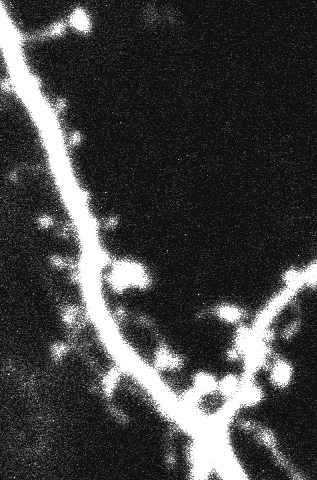Seminars in Hearing Research (10/10/19) - Krishna Jayant, PhD
Seminars in Hearing Research (10/10/19) - Krishna Jayant, PhD
| Author: | M. Heinz |
|---|---|
| Event Date: | October 10, 2019 |
| Hosted By: | Michael Heinz |
| Time: | 1030-1120 |
| Location: | LYLE 1150 |
| Contact Name: | Heinz, Michael |
| Contact Email: | mheinz@purdue.edu |
| Open To: | All |
| Priority: | No |
| School or Program: | Biomedical Engineering |
| College Calendar: | Show |
Seminars in Hearing Research at Purdue (SHRP)
Title: From synapse to soma: nanoelectrode electrophysiology for mapping brain activity across scales
Speaker(s): Krishna Jayant, Ph. D., Assistant Professor, Weldon School of Biomedical Engineering
Date: Oct 10, 2019
Time: 10:30 – 11:20 am
Location: LYLE 1150
Abstract:
Dendritic spines, characterized by a small head (volume~0.01-0.1μm3) and narrow neck (diameter~0.1μm, length~1μm), are the primary site of excitatory synaptic input in the mammalian brain. Synaptic inputs made onto spines first integrate onto dendrites, and subsequently propagate towards the soma and axon initial segment, where they further integrate with other inputs to determine overall action potential output. Elucidating the electrical properties of spines is thus paramount for understanding the first steps along this signal processing chain. Yet, their micron/sub-micron size has rendered conventional whole-cell intracellular electrophysiology infeasible. In the first part of this talk, I will introduce quantum-dot labeled quartz nanopipettes (15-30 nm diameters) which under two-photon visualization enables targeted intracellular recordings from spines1and small pre-synaptic terminals. I will show through detailed experiments that (i) spines receive large EPSPs (25-30mV), and (ii) estimated neck resistances are large enough to influence electrical isolation (mean ~420 M), and filter synaptic input as it invades the dendrite. I will then briefly describe the theoretical implications of these properties2. In the second part of this talk, I will describe a new method in which I combine the flexible property of these nanopipettes with microprisms to enable simultaneous two-photon calcium imaging and targeted intracellular electrophysiology across (a) cortical depth3; (b) different cell types; (c) somatic and dendritic segments; and (d) anaesthetized and awake head-fixed locomoting mice. As a prototypical application of the method, I will describe targeted intracellular recordings from PV+ interneurons, while simultaneously imaging epileptic seizure spread across cortical layers. I will also give a succinct overview of recent work on biomimetic nanopipettes, scanning nanopipette imaging, custom CMOS intracellular amplifiers4, and the fabrication of vertical silicon nanoelectrodes. Finally, I will conclude by describing some recent endeavors at Purdue on nanoelectrode technologies, to decipher dendritic mechanisms underlying the sense of touch.



Bio: Krishna Jayant received his B.Tech degree in electrical engineering from the National Institute of Technology (NIT) Tiruchirappalli, India in 2005, where as part of his bachelor’s thesis he worked on bio-inspired optimization techniques. After brief research stints at IISc Bangalore (2005-2006), and the University of Bologna (2006-2007), both in the area of microelectronics, he joined Cornell University, Ithaca NY, where he received his M.S/PhD in electrical engineering in 2014, working with Prof. Edwin C. Kan. His PhD thesis focused on CMOS floating gate transistors as interfaces to cells and biomolecules. He was the Kavli Post-Doctoral Fellow (awarded twice in two consecutive years) at Columbia University, New York, NY, working with Profs. Rafael Yuste, Ken Shepard, and Ozgur Sahin in the field of neuroscience and CMOS integrated neurotechnology. His laboratory at Purdue works on topics spanning nanoelectronics, CMOS integrated systems, biophysics, and neuroscience.
1 Jayant, K. et al. Targeted intracellular voltage recordings from dendritic spines using quantum-dot-coated nanopipettes. Nat Nano, (2017).
2 Thibault Lagache, Krishna Jayant & Rafael Yuste,. Electrodiffusion modelling of spine voltage dynamics. Under Review (2017)
3 Jayant, K. et al. Flexible nanopipettes for motion-insensitive intracellular electrophysiology in vivo. Cell Reports (2019).
4. Shekar, S., Jayant, K., et al, A miniaturized multi-clamp CMOS amplifier for intracellular neural recording, Nature Electronics, 2019
---
The working schedule for this semester is listed here:
https://purdue.edu/TPAN/hearing/shrp_schedule
The titles and abstracts of the talks is listed here:
https://purdue.edu/TPAN/hearing/shrp_abstracts
Related Link: https://nanoneurotech.com/lab-members/krishna-jayant/

